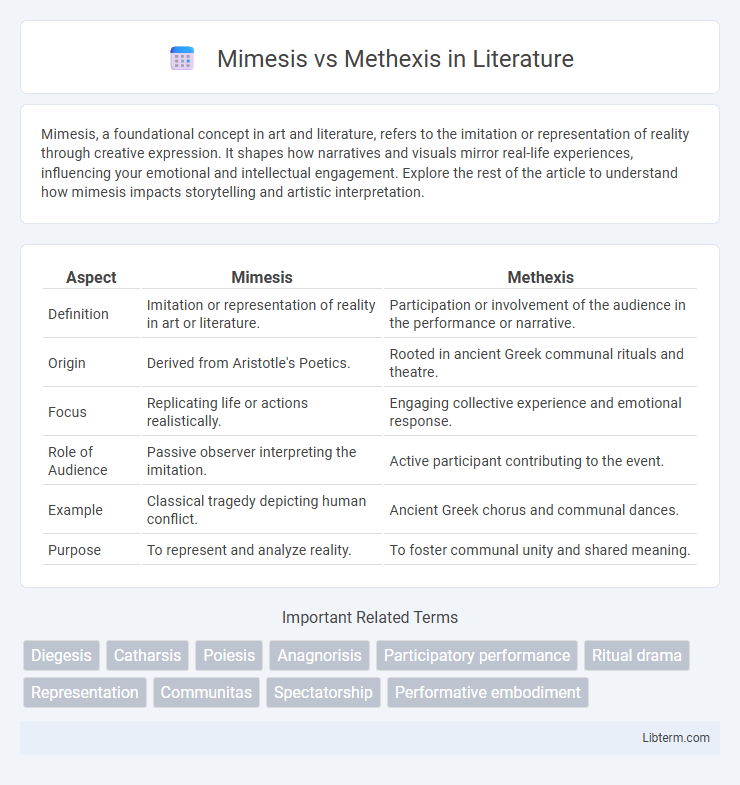Mimesis, a foundational concept in art and literature, refers to the imitation or representation of reality through creative expression. It shapes how narratives and visuals mirror real-life experiences, influencing your emotional and intellectual engagement. Explore the rest of the article to understand how mimesis impacts storytelling and artistic interpretation.
Table of Comparison
| Aspect | Mimesis | Methexis |
|---|---|---|
| Definition | Imitation or representation of reality in art or literature. | Participation or involvement of the audience in the performance or narrative. |
| Origin | Derived from Aristotle's Poetics. | Rooted in ancient Greek communal rituals and theatre. |
| Focus | Replicating life or actions realistically. | Engaging collective experience and emotional response. |
| Role of Audience | Passive observer interpreting the imitation. | Active participant contributing to the event. |
| Example | Classical tragedy depicting human conflict. | Ancient Greek chorus and communal dances. |
| Purpose | To represent and analyze reality. | To foster communal unity and shared meaning. |
Understanding Mimesis: Definition and Origins
Mimesis, rooted in ancient Greek philosophy, refers to the imitation or representation of reality in art and literature, particularly emphasized by Aristotle in his Poetics. It involves the artist's effort to recreate life-like experiences, emotions, and actions to evoke catharsis in the audience. Understanding mimesis requires recognizing its foundational role in shaping narrative forms and dramatic structures by mirroring human behavior and societal norms.
Methexis Explained: A Participatory Approach
Methexis involves active audience participation where spectators collectively engage with the performance, blurring the line between actor and observer. Rooted in ancient Greek theater concepts, Methexis emphasizes communal involvement, fostering a shared, immersive experience. This participatory approach contrasts with Mimesis, which centers on imitation and passive observation, highlighting the dynamic, interactive nature of Methexis in theatrical and ritual contexts.
Historical Contexts: Mimesis and Methexis in Ancient Thought
Mimesis and Methexis emerged as key concepts in ancient Greek philosophy and drama, defining distinct modes of representation and participation. Aristotle's Poetics emphasizes Mimesis as imitation or replication of reality in art, particularly in tragedy, where characters mimic human actions to evoke catharsis. Conversely, Methexis, rooted in Plato's dialogues and communal rituals, represents participatory experience whereby the audience or participants engage directly, sharing in the essence of the event or performance.
Mimesis in Art and Literature
Mimesis in art and literature refers to the imitation or representation of reality, capturing the essence of human experience through detailed depiction. It aims to mirror nature, society, and emotions, enabling audiences to engage with characters and narratives as authentic reflections of life. This concept, rooted in Aristotelian theory, emphasizes faithful replication and practical realism, distinguishing it from Methexis's focus on collective participation or shared experience.
Methexis in Ritual and Performance
Methexis in ritual and performance emphasizes participatory engagement where individuals collectively embody shared experiences, fostering communal unity and transformation. Unlike mimesis, which is imitation or representation, methexis involves active involvement, blurring boundaries between performer and audience to create dynamic, lived expressions of cultural or spiritual narratives. This mode of participation is foundational in traditional rites, theatrical practices, and festivals, strengthening social bonds and reinforcing collective identities.
Key Differences Between Mimesis and Methexis
Mimesis involves imitation or replication of reality, emphasizing representation and mimicry in art or literature, whereas methexis centers on participation or shared experience between the audience and the performance. Mimesis focuses on the depiction of characters and events as separate from the observer, while methexis creates a communal interaction that blurs the line between performer and viewer. Key differences include mimesis's concentration on realistic portrayal versus methexis's emphasis on collective involvement and experiential engagement.
The Role of Audience: Observation vs Participation
Mimesis emphasizes the audience's role as passive observers, where the theatrical experience is a representation of reality designed to be viewed and interpreted from a distance. In contrast, Methexis engages the audience as active participants, often involving communal rituals or improvisational elements that blur the line between performers and spectators. This participatory dynamic fosters a shared experience, transforming the audience from mere onlookers into integral contributors to the unfolding event.
Contemporary Relevance of Mimesis and Methexis
Mimesis and methexis continue to influence contemporary art and literature, where mimesis emphasizes realistic representation and imitation of the external world, shaping genres like photorealism and naturalistic fiction. Methexis fosters audience participation and communal experience, evident in immersive theater and interactive digital media that blur the boundaries between creator and observer. Modern applications of these concepts highlight evolving modes of engagement, reflecting shifts toward both authenticity and collaboration in cultural production.
Mimesis vs Methexis in Modern Theatre
Mimesis in modern theatre emphasizes imitation and representation of reality, where actors replicate characters and scenarios to create a believable narrative. Methexis, by contrast, involves participatory performance that breaks the fourth wall and invites audience engagement, fostering a collective experience rather than mere observation. Contemporary theatre often blends mimesis and methexis to balance narrative immersion with interactive dynamics, enhancing emotional resonance and communal connection.
Conclusion: Bridging Mimesis and Methexis
Bridging Mimesis and Methexis reveals a dynamic interaction between imitation and participation, enriching the understanding of artistic and theatrical expression. Mimesis emphasizes representation, while Methexis involves active involvement, together fostering a holistic experience that engages both creator and audience. This synthesis enhances narrative immersion and emotional resonance, underlining the importance of integrating both concepts in contemporary performance studies.
Mimesis Infographic

 libterm.com
libterm.com